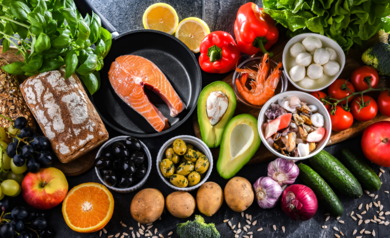- Health Conditions A-Z
- Health & Wellness
- Nutrition
- Fitness
- Health News
- Ayurveda
- Videos
- Medicine A-Z
- Parenting
- Web Stories
This Man Ate Mangoes At 67 And It Triggered A Gout Attack

Credits: Canva
At 67, John, who writes his journey on journee-monidale, had always lived by the book when it came to health. Daily walks, a balanced diet, and plenty of water had kept him active and feeling well into his senior years. But last summer, a surprising dietary choice led to a painful wake-up call—his first gout attack.
The unlikely culprit? Mangoes.
For months, John had been enjoying a large mango every afternoon. He saw it as a wholesome treat—sweet, packed with vitamins, and perfect for a hot day. What he didn’t know was that the natural sugar in mangoes, called fructose, can contribute to high uric acid levels in the blood. In his case, it pushed those levels dangerously high.
According to Dr. Melissa Chen, a rheumatologist at Austin Medical Center, who he spoke to says, “Many patients are shocked to learn that certain fruits can significantly impact uric acid production. Fruits high in fructose can lead to painful gout attacks, especially in older adults with existing risks.”
What Is The Science Behind It?
The science behind it lies in how the body processes fructose. When fructose is broken down, it depletes energy in the cells and increases uric acid as a byproduct. For people with slower kidney function or a genetic tendency to store uric acid, this can be enough to trigger a gout flare.
“Think of fructose as a switch for uric acid production,” explains Dr. Sarah Thompson to John, who is a nutritionist at the New York Wellness Center. “It’s not about cutting out all fruit—it’s about knowing which ones can cause problems.”
Fruits particularly high in fructose include:
- Mangoes
- Apples
- Pears
- Watermelon
- Fruit juices and dried fruits (which are more concentrated sources)
How The Events Unfolded
John’s first attack came suddenly. At 3 AM, he was jolted awake by intense pain in his big toe—so severe, he couldn’t stand the weight of his bedsheet. Tests confirmed his uric acid had spiked to 9.2 mg/dL, well above the recommended maximum of 6 mg/dL.
Once he made the connection to his daily mango intake, John overhauled his diet. He switched to lower-fructose fruits such as:
- Strawberries, which are high in vitamin C
- Cherries, known to reduce inflammation
- Oranges, which offer vitamin C without too much fructose
He also cut out sugary drinks and started paying closer attention to “healthy” foods that might have hidden downsides.
John’s doctor called it the “health halo trap”—the idea that just because something is natural or nutritious, it can be consumed without limits. But for older adults, the body’s ability to manage uric acid declines, and even small missteps can have big consequences.
“Managing uric acid becomes more important with age,” Dr. Chen advises. “Even healthy habits need a second look when your metabolism changes.”
John now is pain-free and wiser about his food choices. His experience is a reminder: sometimes, it’s not about cutting out healthy foods, but understanding how they affect your unique body—especially as it ages.
Even With Alzheimer’s Genes, This Diet Could Lower Your Risk By 35%

Credits: Canva
What if the foods you eat today could protect your brain decades from now? A new study from researchers at Mass General Brigham, Harvard T.H. Chan School of Public Health, and the Broad Institute of MIT and Harvard suggests that following a Mediterranean-style diet could do just that—potentially lowering dementia risk by as much as 35%, even for those genetically predisposed to Alzheimer’s disease.
The Mediterranean diet, long celebrated for its heart- and longevity-promoting benefits, is now gaining attention for its protective effects on the brain. This diet emphasizes plant-based foods, healthy fats such as extra virgin olive oil, nuts, fruits, vegetables, and whole grains, with moderate fish intake. In the recent study published in Nature Medicine, researchers observed that individuals at the highest genetic risk for Alzheimer’s disease particularly carriers of the APOE4 gene variant—showed the most significant reduction in dementia risk when adhering closely to this dietary pattern.
“One reason we wanted to study the Mediterranean diet is because it is the only dietary pattern that has been causally linked to cognitive benefits in a randomized trial,” said Yuxi Liu, PhD, the study’s first author and a research fellow at Brigham and Women’s Hospital and the Harvard Chan School. “We wanted to examine whether these benefits differ among people with different genetic backgrounds and how blood metabolites may mediate this effect.”
Why Diet Important for an Aging Brain?
Brain aging begins in our 30s and 40s, subtly impacting memory, attention span, and cognitive function. Over time, neurons can accumulate toxic proteins associated with Alzheimer’s disease, and chronic inflammation accelerates cognitive decline. Nutrients in the Mediterranean diet—particularly anti-inflammatory compounds in nuts, olive oil, berries, and fish—can slow these processes, protect neurons, and preserve memory.
Fish, especially salmon and sardines, provide omega-3 fatty acids, which studies from Harvard Medical School have linked to reductions in amyloid-beta accumulation, a hallmark of Alzheimer’s disease. For those who do not consume fish, walnuts serve as an excellent source of protein and healthy fats, with research from UCLA highlighting improved cognitive outcomes from consuming roughly a handful daily. Leafy greens, berries, and coffee also feature prominently in the diet, supporting memory retention, lowering inflammation, and providing neuroprotective antioxidants.
Foods to Eat and Avoid
The study reinforced that anti-inflammatory foods are key. Meals like Greek yogurt with berries for breakfast, quinoa salads for lunch, and salmon with beans and spinach for dinner offer a template for brain-healthy eating. Conversely, diets high in sugar, salt, processed foods, and fried items—think pizza, ice cream, and hot dogs—can elevate systemic inflammation, potentially accelerating cognitive decline.
“While our research doesn’t prove a Mediterranean diet directly reduces amyloid plaque deposition, it clearly demonstrates that this dietary pattern is associated with better cognitive outcomes and slower memory loss over time,” Liu explained.
What Are The Genetic Factor for Alzheimer’s Risk?
Alzheimer’s disease has a strong genetic component, with heritability estimated at up to 80%. The APOE gene, specifically the APOE4 variant, is the most significant genetic risk factor for sporadic Alzheimer’s disease. Individuals carrying one copy of APOE4 have a three- to four-fold higher risk, while those with two copies have a twelve-fold increase in risk.
The new research demonstrated that even among APOE4 carriers, adherence to a Mediterranean diet mitigated genetic risk, emphasizing that lifestyle choices can meaningfully influence outcomes even when genetics are not in one’s favor.
To assess the interaction between diet, genetics, and cognitive health, researchers analyzed data from 4,215 women in the Nurses’ Health Study from 1989 to 2023, supplemented with 1,490 men in the Health Professionals Follow-Up Study from 1993 to 2023. Blood metabolites were examined alongside dietary questionnaires, and participants were tracked for incident dementia cases. A subset of women underwent telephone-based cognitive testing to assess memory changes over time.
The findings consistently showed that participants who closely followed a Mediterranean-style diet had slower cognitive decline and lower dementia risk, with the strongest effects among those genetically predisposed.
How Food Influences the Brain?
Beyond inflammation reduction, the study explored metabolites—small molecules that indicate how the body processes nutrients. These metabolites may modulate pathways involved in brain health, including lipid metabolism, oxidative stress, and energy production. By influencing these pathways, a Mediterranean diet could exert a systemic neuroprotective effect, particularly in individuals with high genetic susceptibility.
“Targeting specific metabolic pathways through diet may eventually allow personalized interventions for dementia prevention,” Liu noted.
Are There Any Limitations to Consider Before?
While the results are compelling, the study cohort was primarily well-educated individuals of European ancestry, highlighting the need for research in more diverse populations. Additionally, genetics and metabolomics are not yet integrated into most clinical risk models for Alzheimer’s disease, and many people do not know their APOE status. Future research aims to expand these findings into broader, personalized dietary recommendations and explore whether specific metabolites can be targeted to reduce cognitive decline further.
How To Eat for a Healthy Brain?
Even without genetic testing, adopting a Mediterranean-style diet offers measurable cognitive benefits. Key practices include:
Prioritizing plant-based foods, healthy fats, and whole grains
Add fish or omega-3-rich alternatives like walnuts
Consuming berries, leafy greens, and moderate coffee
Limiting processed, sugary, and fried foods
As science increasingly links nutrition to brain health, these lifestyle strategies provide actionable ways to protect cognition, even for those at elevated genetic risk.
Alzheimer’s may have strong genetic roots, but diet emerges as a powerful, modifiable factor. This study underscores the potential of the Mediterranean diet not only to reduce dementia risk by up to 35% but also to slow age-related cognitive decline, offering hope that what we eat today can shape our brains for decades to come.
Could Omega-3 Fatty Acids Be The Dietary Fix For Your Kids Nearsightedness?

Credits: Canva
If your child spends hours glued to screens, you’ve probably worried about their eyesight. But here’s something surprising, could a nutrient as simple as omega-3 help protect them from nearsightedness? A new study says yes—and the findings might change how parents think about everyday nutrition and eye health.
omega-3 fatty acids have been touted for their potential to promote heart health, reduce inflammation, and even guard the brain. They're what make salmon, walnuts, and chia seeds so well-touted as "superfoods." But scientists are now discovering another intriguing possibility: omega-3s might help guard vision too.
Nearsightedness, or myopia, is on the verge of becoming the most prevalent child health problem in the world. It's no longer out of the ordinary for a kid to receive their first eyeglasses before the age of ten. An estimated nearly half of the world's population may suffer from myopia by the year 2050. Heredity has something to do with it, but so does lifestyle—particularly during an era of digital screens, restricted outside playtime, and an unbalanced diet.
The question researchers are raising is- Does what children eat make a quantifiable difference in the way their eyes grow? Based on new research released in the British Journal of Ophthalmology, the answer may be yes.
The research, conducted by Dr. Jason Yam, a professor of ophthalmology at the Chinese University of Hong Kong, monitored over 1,000 children aged 6 to 8. Researchers monitored their diets via questionnaires and compared them with comprehensive eye examinations. Here's what they discovered:
Youngsters with the lowest intake of omega-3 fatty acids had the longest axial length (from front to back of the eye). A longer axial length is associated with myopia directly.
Children with a greater intake of omega-3 had the shortest axial length, indicating a shield against nearsightedness.
Individuals with greater intake of saturated fats—found in foods such as butter, palm oil, and red meat—had a more pronounced indication of developing myopia.
Simply put, kids who consumed more omega-3s were less likely to exhibit the physical eye changes that cause nearsightedness.
Dr. Yam and his researchers concluded that omega-3s could be "a potential protective dietary factor against myopia development."
What Is Nearsightedness or Myopia?
Nearsightedness results when the form of the eye leads light rays entering the eye to converge ahead of the retina, instead of directly on it. This causes objects in the distance to blur.
The condition usually arises during childhood and stabilizes by adulthood, but its complications can stretch much further than the prescription for glasses. High myopia raises the risk of retinal detachment, glaucoma, and cataracts in later life. Changes in lifestyle in today's world are driving its increase:
- Increased screen time and less exposure to natural light outdoors
- Sedentary lifestyles and less physical activity
- Nutritional deficits that impact bone and eye growth
The new research indicates that omega-3s could directly affect eye growth, perhaps by enhancing blood supply and maintaining a healthy retinal and corneal growth.
How Omega-3s Helps Protect Vision?
Omega-3 fatty acids are essential nutrients that the body is unable to generate by itself and, therefore, need to be obtained from diet. They come in three forms: ALA (alpha-linolenic acid), present in vegetable sources such as walnuts, flaxseeds, chia seeds, and hemp seeds; DHA (docosahexaenoic acid), a brain and retina structural component crucial to health, present mainly in fish, algae, and other sea foods; and EPA (eicosapentaenoic acid), which is present in fish and algae as well, notable for its anti-inflammatory effect.
Of these, DHA is particularly vital to eye function and development. One of the richest tissues in DHA, the retina has been found through human and animal research to have compromised vision from deficiencies in early life. New evidence now indicates that the role of omega-3s is not limited to cardiac and neurological well-being but could also play a protective function in maintaining the vision of children through formative developmental years.
How do Parents Assist in Precluding Myopia in Children?
Across the world, nearsightedness rates are rising at alarming rates. By 2050, almost 5 billion individuals will be myopic. The increase is particularly steep in East Asia, where intense schooling pressures, prolonged near vision work, and diet changes overlap but Western nations are following fast. More screen time for kids, less outdoor time, and processed food diets rich in saturated fats have provided an ideal environment for eye issues.
If left unchecked, myopia's burden will stress health systems and impact quality of life for millions. Prevention measures—such as dietary interventions—are therefore critical.
Other Health Benefits of Omega-3s
This is not the first instance that omega-3s have been associated with eye wellness. Earlier studies have identified that they can lower the risk of:
Age-related macular degeneration (AMD) is a common cause of blindness among older adults
Dry eye disease: Omega-3s may enhance tear quality and alleviate inflammation
- In addition to eye care, omega-3s are linked with:
- Reduced risk of heart disease
- Enhanced brain function and reduced dementia risk
- Improved mood and alleviated depression symptoms
- Lessened inflammation in the body
Another study published by King's College London has recently discovered that omega-3s may also lower the risk of Alzheimer's in women, further highlighting their wide-ranging protective benefits.
How to Add Omega-3 Rich Foods in Your Diet?
For households wishing to enhance children's omega-3 levels, diet is the key.
Oily fish: Salmon, mackerel, sardines, and tuna are richest in DHA and EPA.
Plant sources: Walnuts, chia seeds, flaxseeds, and hemp seeds contain ALA, which the body can partially convert into DHA and EPA.
Algae-based supplements: A vegetarian option for those following a plant-based diet.
Experts advise that children consume at least two portions of fish every week, although supplements can be beneficial in instances of diet limitations or fussy eating.
Why Balance Is Important in Your Diet?
Although omega-3s seem to be protective, the research also points out what not to excess: saturated fats. Diets rich in processed meats, butter, and palm oil were linked with higher indicators of myopia in children.
Diet is only one part of the equation. Outdoor activity, reduced screen time, and frequent eye exams are all just as crucial in safeguarding children's vision.
The new study doesn't show omega-3s can prevent nearsightedness outright, but it provides strong evidence that nutrition is involved in eye development. For caregivers and parents, it's another reminder that what kids eat influences not only how they grow up, but how they experience the world literally.
As Dr. Yam's group points out, omega-3s are turning out to be a "potential protective dietary factor against myopia development." Whether in a piece of grilled salmon or a handful of chia seeds, increasing the family diet with more omega-3s may be a practical, easy solution to healthier eyes.
Cardiologist Shares 3 'Healthy Breakfast' Foods That Silently Raise Your Blood Pressure

(Credit-Canva)
While we blame white rice, morning drinks like coffee or tea, a simple unsuspecting breakfast could be the culprit behind your rising blood sugar. Many people have switched to healthier options for their breakfast favorites, whether it is sugarless coffee, or whole fruits. However, not everything we consider healthy is true. Dr Sanjay Bhojra, a Board-Certified Cardiologist, lists 3 breakfast items we believe to be healthy, which could be the silent cause behind your rising blood pressure.
What ‘Healthy’ Foods Are The Cause Of Blood Pressure Spike?
Dr Bhojra lists these 3 food items as if they might actually be harming your cardiovascular system.
- Whole grain toast.
- Instant oatmeal packets.
- Even certain granolas.
While they are often recommended by doctors and found on every "heart-healthy" list, these seemingly harmless foods contain hidden components that can lead to an unhealthy start to your day. This can unknowingly cause problems that build up over time, affecting your long-term heart health.
How Does Unhealthy Breakfast Affect Your Body?
Dr Bhojra explains that starting your day with these foods can cause your blood pressure to spike before 9 a.m. This happens because of a combination of factors. The hidden sodium in many of these products leads to fluid retention, causing your body to hold onto more water. Additionally, the refined carbohydrates can cause a sharp increase in insulin and stress hormones. Together, these effects can drive inflammation in your body right at the beginning of the day, setting a negative tone for your cardiovascular system.
What Are The Long Term Impacts of High Blood Pressure?
When your blood pressure consistently remains high in the morning, it can gradually chip away at your cardiovascular health. This persistent elevation can put extra stress on your heart and blood vessels, potentially leading to more serious issues over time. Instead of these foods, a better approach is to choose a breakfast that works to stabilize your blood sugar, reduce inflammation, and truly support a healthy heart from the moment you wake up.
Heart-Healthy Breakfast Options You Should Eat
Even if you are someone who lives on the run and cannot spend extended time and want a quick breakfast then you may often resort to these quick breakfasts from the Heart and Stroke Foundation of Canda. Save time by preparing your breakfast the night before or over the weekend.
- Repurpose last night's whole-wheat pasta or homemade pizza by warming it up for breakfast.
- Keep a batch of whole-grain, low-fat muffins or bread in the freezer. In the morning, just grab one and pair it with yogurt and a banana.
- Cut up fresh fruit the night before to use as a quick topping for yogurt or cereal.
- Mix rolled oats with yogurt and milk, adding fruit or seeds. Simply refrigerate overnight for a ready-to-eat breakfast.
- Boil a few eggs in advance and store them in the fridge for a quick protein boost.
- A soft-cooked egg on whole-wheat toast with orange slices
- Scramble eggs with red peppers and salsa and wrap in a tortilla.
- Layer plain yogurt, whole-grain cereal, and fresh berries.
- The first ingredient listed should be a whole grain.
- Aim for a cereal with 4 grams of fiber or more per serving.
Look for cereals with 6 grams of sugar or less per serving. If it contains dried fruit, the sugar content may be slightly higher, but still check that sugar ingredients are listed toward the end of the list.
© 2024 Bennett, Coleman & Company Limited

